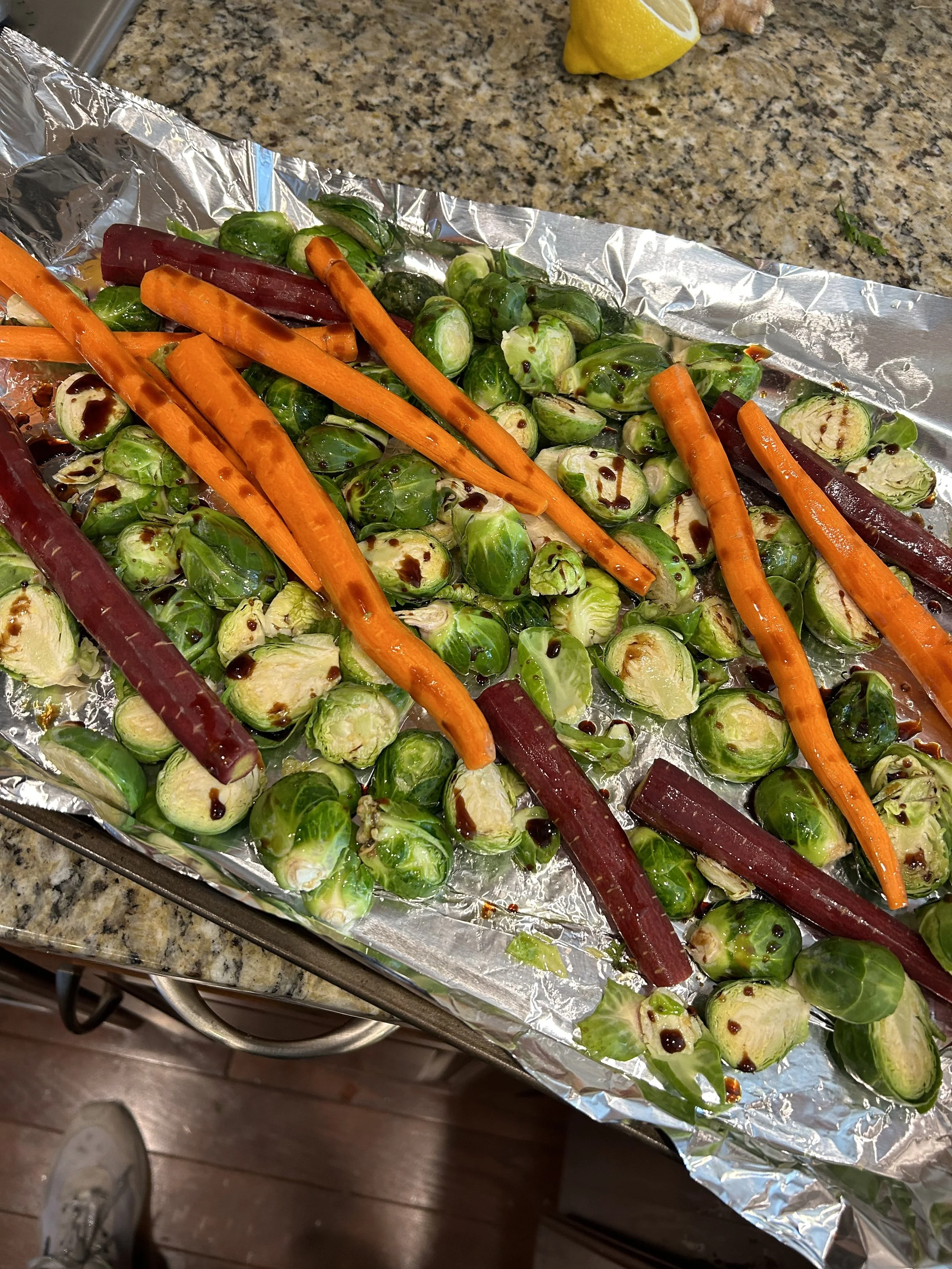Roasting root vegetables
Root vegetables, a diverse category of nutrient-dense foods, possess specific Ayurvedic qualities and attributes that make them suitable for various constitutions and seasons. Here are the Ayurvedic qualities of root vegetables:
Grounding (Stability): Root vegetables grow underground and have a grounding quality, making them excellent choices for balancing Vata dosha, which tends to be airy and ungrounded. Their stabilizing nature helps anchor the body and mind.
Sweet Taste (Madhura Rasa): Root vegetables, such as carrots, sweet potatoes, and beets, typically have a sweet taste. The sweet taste is nourishing and soothing, making these vegetables suitable for pacifying both Vata and Pitta doshas.
Heaviness (Guru Guna): Root vegetables are often considered heavy in quality (guna) due to their dense, substantial nature. This heaviness can be particularly beneficial for Vata dosha, as it counteracts Vata's light and airy qualities.
Warming (Ushna Virya): While not excessively heating, many root vegetables have a slightly warming energy, which can help balance Vata and Kapha doshas. However, they are generally well-tolerated by Pitta individuals, especially when cooked.
Sustaining (Nourishing): Root vegetables are rich in carbohydrates, fiber, and essential nutrients. They provide sustained energy, making them a staple in Ayurvedic diets, especially during the fall and winter when grounding foods are favored.
Starchy Content: The starch content in root vegetables supports the digestive system and helps stabilize blood sugar levels, making them suitable for individuals with varying dosha constitutions.
Seasonal Alignment: Root vegetables are often harvested in the late summer and fall, aligning with Ayurvedic principles of eating seasonally. Their availability during these seasons makes them a natural choice for nourishment.
Variety: Different root vegetables offer unique qualities. For example, carrots and sweet potatoes are sweet and grounding, while radishes and turnips have a more pungent quality, which can stimulate digestion.
In Ayurveda, root vegetables are valued for their ability to provide essential nutrients, promote stability, and harmonize the body with the changing seasons. They are considered an excellent addition to a balanced diet, offering versatility in cooking and culinary creativity while supporting overall health and well-being.
In Ayurveda, the preferred culinary technique for root vegetables often involves cooking methods that enhance their grounding and nourishing qualities while making them easier to digest. Here are some preferred culinary techniques for preparing root vegetables:
Steaming: Steaming root vegetables is a gentle cooking method that helps retain their natural sweetness and nutritional value. It softens the vegetables without making them overly heavy, making them suitable for all dosha types.
Roasting: Roasting root vegetables with a small amount of ghee or oil can enhance their flavor and bring out their natural sweetness. This method can make root vegetables more palatable for those who are not accustomed to their taste.
Sautéing: Sautéing root vegetables with warming spices like cumin, coriander, and turmeric can enhance their digestibility and flavor. Use a moderate amount of oil or ghee to promote easy digestion.
Boiling: Boiling root vegetables in soups or stews is a common method, especially during colder seasons. Adding digestive spices like ginger, black pepper, and asafoetida (hing) can aid in their digestion.
Mashing: Mashed root vegetables, such as mashed sweet potatoes or mashed turnips, can be comforting and nourishing. Add a touch of ghee or spices like cinnamon or nutmeg for extra flavor and warmth.
Baking: Baking root vegetables can result in a slightly sweeter and caramelized flavor. This method can be particularly enjoyable during the fall and winter months.
Grating: Grating root vegetables and consuming them raw or lightly dressed in a vinaigrette can be refreshing and suitable for Pitta types. Be mindful of the quantity, as raw root vegetables can be heavy for some.
Combining with Spices: Seasoning root vegetables with Ayurvedic spices like cumin, coriander, fennel, and ginger can aid in digestion and enhance their taste and nutritional value.
It's important to consider your individual constitution (Prakriti) and any current imbalances (Vikriti) when choosing the best cooking method for root vegetables. For example, Vata types may benefit from slightly heavier and oilier preparations, while Pitta types may prefer lighter cooking methods. Kapha types can benefit from roasted or sautéed preparations with digestive spices to balance their innate heaviness.
Ultimately, the choice of cooking technique should align with your dosha constitution, the season, and your current state of health to optimize the nourishing and grounding qualities of root vegetables.
This past weekend I chose to bake my locally farmed root vegetables with olive oil and a cherry balsamic vinegar I found recently at Whole Foods. Seasoned only with salt and pepper, it was delicious!




